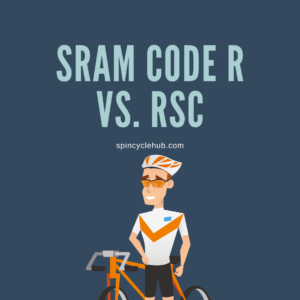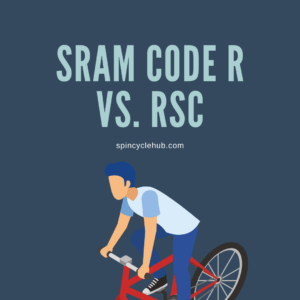Introduction
When it comes to mountain biking, having reliable and efficient brakes is crucial for both safety and performance. SRAM, a renowned brand in the cycling industry, offers a range of brake systems to cater to different riders’ needs. Among their popular options, the SRAM Code R and RSC brakes stand out as formidable contenders. In this article, we’ll dive into a detailed comparison of the SRAM Code R and RSC brakes, exploring their features, performance, and suitability for various riding styles.
SRAM Code R – Unleash the Power
The SRAM Code R brakes are designed to provide reliable stopping power, especially for aggressive trail and enduro riding. These brakes feature a robust construction with a four-piston caliper that delivers consistent and strong braking performance. The large reservoir and increased fluid volume ensure better heat management, reducing the chances of brake fade on long descents.

The Code R brake system offers excellent modulation, allowing riders to finely control their braking power. This modulation is particularly beneficial in technical sections of the trail, where precise braking is essential to maintain control and speed. When you need to scrub off speed quickly before entering a tight corner, the Code R brakes respond with confidence-inspiring performance.
While the Code R brakes excel in power and modulation, they may not be as lightweight as some other options on the market. Additionally, some riders might find the lever design a bit bulky for their liking. However, the Code R brakes make up for these imperfections with their dependable performance in aggressive riding scenarios.
Personal Experience: I remember one adrenaline-pumping downhill run where I relied heavily on my SRAM Code R brakes to navigate through steep sections and technical drops. The brakes remained responsive, providing the stopping power I needed to tackle the challenging terrain with confidence.
SRAM Code RSC – Precision and Finesse
The SRAM Code RSC brakes take the reliable stopping power of the Code R to the next level with enhanced adjustability and precision. The tool-free reach adjustment allows riders to fine-tune the lever position, catering to different hand sizes and riding preferences. The Code RSC’s SwingLink™ technology ensures that the pads contact the rotor with a smooth and consistent feel, enhancing modulation and control.
The four-piston caliper design of the Code RSC maintains the strong braking performance, but the lever ergonomics offer improved comfort during long rides. The lever blade shape is designed to reduce hand fatigue and provide a comfortable grip, making it ideal for all-day adventures on the trails.
One standout feature of the Code RSC brakes is their reach adjustability. Riders can easily adjust the distance of the brake lever from the handlebar, accommodating various hand sizes and preferences. This level of customization enhances the overall riding experience, ensuring a comfortable and confident grip on the brake lever.
As with any product, there are some trade-offs. The enhanced features and adjustability of the Code RSC brakes come at a slightly higher price point compared to the Code R. Additionally, while the Code RSC provides precision and finesse, it may not match the sheer brute force of the Code R in aggressive downhill scenarios.
Personal Experience: On a recent cross-country ride, I had the opportunity to test the SRAM Code RSC brakes. The reach adjustability allowed me to find the perfect lever position, reducing hand fatigue during the long climbs and providing precise modulation during technical descents.
Power and Modulation: Code R vs. RSC
When it comes to power and modulation, both the Code R and RSC brakes perform admirably. The Code R’s four-piston caliper delivers strong and consistent braking power, instilling confidence in riders tackling steep descents and technical trails. The modulation allows for precise control, enabling riders to brake smoothly and effectively in various situations.
The Code RSC builds upon the Code R’s performance by offering enhanced modulation and adjustability. The SwingLink™ technology ensures a progressive and consistent pad contact, allowing riders to modulate their braking power with finesse. The reach adjustability feature of the Code RSC enables riders to personalize their lever position, enhancing control and comfort.
In terms of sheer stopping power, the Code R may have a slight advantage due to its robust construction and larger fluid volume. This makes it a popular choice among downhill enthusiasts and riders who prioritize pure power over finesse. However, for riders who value precision and a customizable riding experience, the Code RSC’s enhanced modulation and reach adjustability make it an attractive option.
Lever Design and Ergonomics
The lever design and ergonomics play a crucial role in a rider’s comfort and control on the bike. The Code R features a solid lever design that offers a secure grip, providing riders with confidence when squeezing the brakes. However, some riders may find the Code R lever slightly bulkier compared to other options on the market.
On the other hand, the Code RSC introduces improved ergonomics with its lever blade shape and reach adjustability. The lever blade shape is designed to reduce hand fatigue during long rides, allowing riders to maintain control and comfort throughout their adventures. The reach adjustability feature ensures that riders can find the perfect lever position to suit their hand size and riding style.
While both brake systems provide a secure and reliable lever feel, the Code RSC’s ergonomic improvements make it a preferred choice for riders who prioritize long-term comfort and reduced hand fatigue.
Maintenance and Servicing
Proper maintenance and regular servicing are essential for the longevity and performance of any brake system. In terms of maintenance, both the Code R and RSC brakes are relatively straightforward to maintain.
Bleeding the brakes and replacing brake pads can be done without much hassle, thanks to the user-friendly design of both systems. However, the Code RSC’s reach adjustability feature may require some additional attention during maintenance to ensure that the lever position is properly adjusted after bleeding the brakes.
In terms of long-term durability, both brake systems have proven to be reliable options. With proper care and maintenance, they can withstand the demands of aggressive riding styles and provide consistent performance over time.
Pricing and Value for Money
When it comes to pricing, there is a slight difference between the Code R and RSC brake systems. The enhanced features and adjustability of the Code RSC come at a slightly higher price point compared to the Code R.
However, when evaluating the value for money, it’s important to consider the specific needs and preferences of the rider. For riders who prioritize raw power and straightforward performance, the Code R provides excellent value. On the other hand, riders who value enhanced modulation, precision, and customizable ergonomics may find the Code RSC to be worth the slightly higher investment .Ultimately, the decision between the two brake systems will depend on the rider’s priorities and budget.
Riding Style Suitability
The suitability of the SRAM Code R and RSC brakes for different riding styles is an important consideration. Both brake systems excel in aggressive trail and enduro riding, where consistent stopping power and control are essential.
For riders who focus primarily on aggressive downhill riding, the Code R’s raw power may be the preferred choice. Its strong braking performance and reliable modulation make it a popular option among downhill enthusiasts.
On the other hand, for riders who seek a balance between power, modulation, and personalized control, the Code RSC offers a more refined and customizable experience. Its enhanced modulation and adjustability make it well-suited for riders who value finesse and precision on the trails.
User Feedback and Reviews
User feedback and reviews play a significant role in understanding real-world experiences with the SRAM Code R and RSC brakes. It’s important to consider a range of opinions and experiences to make an informed decision.
Overall, both brake systems have garnered positive reviews, with riders praising their stopping power, reliability, and performance. The Code R is often commended for its raw power and consistency in aggressive riding scenarios, while the Code RSC receives praise for its modulation, customization options, and ergonomic improvements.
However, it’s worth noting that personal preferences and riding styles can influence individual experiences. What works well for one rider may not necessarily be the best fit for another.

Conclusion
In conclusion, the SRAM Code R and RSC brakes are both impressive options that cater to different riding styles and preferences. The Code R excels in raw power and consistent braking performance, making it a popular choice for aggressive downhill riding. On the other hand, the Code RSC offers enhanced modulation, adjustability, and ergonomic improvements, providing a more refined and customizable experience for riders seeking precision and finesse.
When making a decision between the two brake systems, it’s important to consider factors such as power, modulation, lever design, ergonomics, maintenance requirements, pricing, and riding style suitability. Ultimately, the best choice will depend on the rider’s individual preferences, priorities, and budget.
FAQs (Frequently Asked Questions)
1. Are the SRAM Code R and RSC brakes compatible with all mountain bikes?
– Yes, the SRAM Code R and RSC brakes are compatible with most mountain bikes that have the necessary brake mount fittings.
2. Can I upgrade my existing SRAM Code R brakes to Code RSC?
– Yes, it is possible to upgrade your existing SRAM Code R brakes to Code RSC by purchasing the Code RSC lever assembly and caliper separately. However, it’s advisable to consult a professional bike mechanic for proper installation.
3. Are the SRAM Code RSC brakes worth the higher price compared to the Code R?
– The decision depends on your priorities as a rider. If you value enhanced modulation, adjustability, and ergonomic improvements, the Code RSC is worth the investment. However, if raw power and consistent performance are your main focus, the Code R provides excellent value.
4. How often do I need to bleed the SRAM Code R and RSC brakes?
– The frequency of brake bleeding depends on various factors, including riding conditions and personal preference. As a general guideline, it’s recommended to bleed the brakes annually or when you notice a decrease in braking performance.
5. Can I use the SRAM Code R or RSC brakes for cross-country riding?
– While the SRAM Code R and RSC brakes are designed with aggressive riding in mind, they can still be used for cross-country riding. However, riders who prioritize lightweight and minimalist designs may prefer other options specifically tailored for cross-country riding.
- Pinkbike’s Review of SRAM Code R and RSC Brakes: Pinkbike is a popular mountain biking website that provides in-depth reviews of various mountain biking components, including brakes. This review offers insights into the performance and real-world experiences of the SRAM Code R and RSC brakes.
- SRAM Official Website – Code Series Brakes: For those interested in detailed technical specifications and official information about the SRAM Code R and RSC brakes, SRAM’s official website is a reliable source. Here, you can find product descriptions, features, and additional resources related to the Code series brakes.
Watch this one,
Video Credits – Flow Mountain Bike
DOWNLOAD THIS ARTICLE :SRAM Code R vs. RSC
You May Also Like
-
Spank Vibrocore Bars vs Carbon Bars: Choosing the Right Handlebars for Your Ride
-
SRAM MTH 746: Unleashing the Power of Instantaneous Response
-
32T vs 34T Chainring: Finding the Perfect Gear for Your Ride




